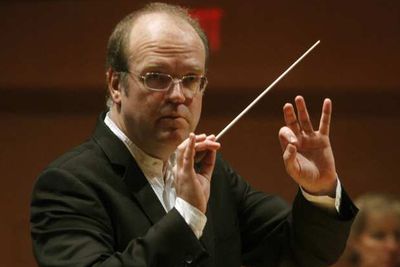Labadie leads a soloist-driven Mozart Requiem with the Philharmonic
On Thursday night, Bernard Labadie led the New York Philharmonic in its first performance of Mozart’s Requiem in over ten years (It is curious that this piece manages to remain a dazzlingly popular staple of the repertoire despite not being attempted all that often.) Friday night’s repeat at Avery Fisher Hall began with some smaller baroque repertoire to complement Mozart’s imposing mass.
There was an intimate group on stage, only about twenty-five players, for Bach’s Cantata No. 51, Jauchzet Gott in allen Landen. The Swedish soprano Miah Persson sounded slightly heavy for the first aria, though she reined in her sound somewhat in the recitative, finding a rich, honeyed tone. Still, the performance seemed detached, with unfocused phrasing,, and in the second araa her pitch wandered a bit, usually south. The chorale had more shine all around, with playful bubbling in the strings and continuo. Persson was lighter in color in the Alleluja, but still felt reserved.
The soprano brightened considerably in “Let the Bright Seraphim” from Handel’s oratorio Samson. Persson seemed altogether more comfortable here, coming alive as she ranged through her lighter upper register, and nimbly dispatched the daunting coloratura passages. In both the Handel and the Bach, Matthew Muckey displayed sensitivity and agility in the trumpet part.
So much ink has been spilled in the last fifty years over the issue of Mozart’s Requiem and its completion, the discussion and its manifestation in performance have often become tedious. Every conductor seems to have a different horse in the race, with the only consensus being that it is decidedly unsexy to perform the Requiem as completed by Mozart’s pupil Franz Xaver Süssmayr.
The Philharmonic performed the 1993 completion by Robert Levin, a version that, like the rest, has its ups and downs. It preserves much of what Süssmayr wrote, notably some of the later sections that are almost entirely in his hand, making changes in orchestration and a few structural additions. The “Osanna” fugue that ends the “Sanctus” and “Benedictus” is fleshed out considerably, and an “Amen” fugue is inserted at the end of the Sequence, giving the piece structural consistency and bringing the Lacrimosa to a more complete, satisfying end.
In other spots, though, this reconstruction frustrates, as at the end of the “Benedictus,” where the sudden interruption of the “Osanna” sounds hurried and slapdash. The orchestral part in the “Sanctus” is trimmed down until it sounds downright dainty, and the changes to the accompaniment in the “Lacrimosa” are largely superficial.
Labadie’s account of the Requiem was not adventurous; his tempos were were mostly tame but well-considered. Only in the “Tuba mirum” did his pace seem off, as he rushed the trombone solo at the beginning. For the rest, he had a clear sense of the mass’s structure, never losing direction as he drew a clear thread from the first bar to the last.
The soloists assembled for this performance were admirable. In addition to Persson, who kept the light, clear tone that had been so effective in the Handel, the tenor Frédéric Antoun brought a shining and occasionally explosive ring to his part. Andrew Foster-Williams was listed in the program as a bass, though his timbre is light enough that he sounds for all the world like a baritone. At any rate, he has a powerful voice that served him well in his “Tuba Mirum” solo.
Most notable of the four was the mezzo-soprano Stephanie Blythe. A standout as Fricka in last year’s Ring cycles at the Met, the power of her voice is second to none, but nowhere did she overwhelm the music on Friday, instead singing with arresting simplicity.
Having such a formidable quartet on hand should have been a great boon to Labadie, but he pushed them too much. It’s not often that you hear the soloists overwhelm the orchestra, but the conductor had them positively blaring, particularly the men, throwing off the balance of the sound.
Elsewhere, however, his emphasis on vocal power was effective. Even though he kept the orchestra mostly in check, there was nothing about his interpretation that seemed small: rather, there was both power and purity as Labadie relied on the direct and enveloping sound of Joseph Flummerfelt’s New York Choral Artists. The “Dies Irae” was terrifying, and the “Agnus Dei” really did inspire awe, rich, confident, and pensive as it was.
Labadie was at his best in the fugues, even though the second “Osanna” got a little out of hand. The “Cum sanctis” had marvelous, spinning intensity, driving forward to the lucid resolution.
The New York Philharmonic will repeat the program 8 p.m. Saturday at Avery Fisher Hall. nyphil.org
